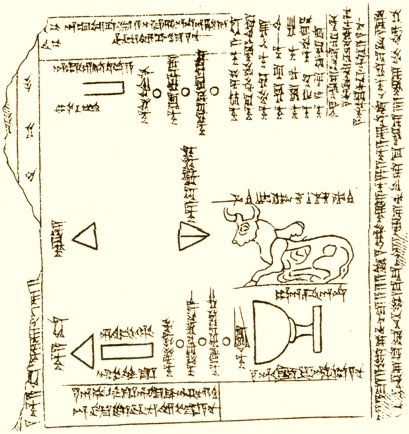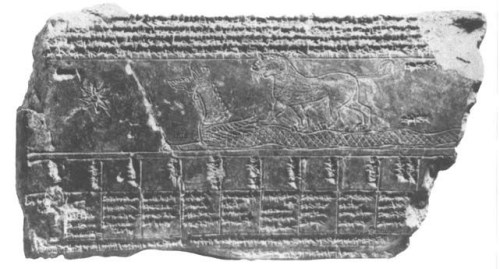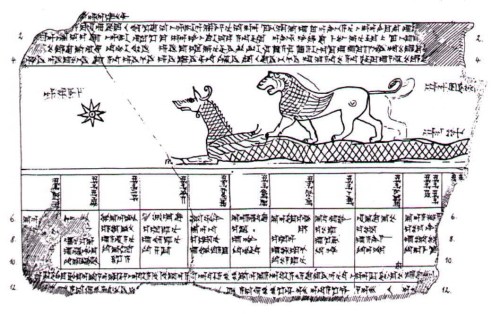The Historicity of Berossus
“Some sources suggest that Berossos had, as it were, an international career as an astronomer. According to those sources, he left Babylon and migrated to the Greek world after the publication of his history.
Vitruvius states that he moved to the island of Cos and opened a school there (BNJ T 5a-b). Vitruvius also ascribes the invention of a specific type of sundial to Berossos (BNJ 680 T 5c).

The Bull of Heaven, Taurus, is drawn on an “esoteric tablet” dated to the Seleucid era. See Textes cuneiform du Louvre by Francois Thureau-Dangin, Tome VI (Tablets d’Uruk, a la usage des pretres du temple d’Anu au temps des Seleucides), (Plate 91), 1922. The same plate is reproduced in Astrological Reports to Assyrian Kings, Herman Hunger, 1992, p. 40.
http://members.westnet.com.au/gary-david-thompson/page11-10.html
Josephus agrees with the Roman architect that Berossos propagated Babylonian lore: he says that the Chaldaean was famed among those who were engaged in learning, because he published for the Greeks works on astronomy and on the philosophy of the Chaldaeans (BNJ 680 T3).
Pliny the Elder presents Berossos as the most important scholar of astronomy/astrology and adds that the Athenians honoured him with a statue with a gilded tongue because of his divine predictions (BNJ 680 T 6).
The historicity of these biographical data is subject to debate. Burstein and Verbrugghe / Wickersham accept the ‘second’ life of Berossos as historical. Schwartz rejects the testimony according to which Berossos opened a school on Cos, because he thinks it unlikely that the Babylonian priest would have abandoned his prebendary income in Babylon.

Leo with Corvus standing on Hydra (VAT 7847 (= VAN 784 Staatliche Museen zu Berlin)
VAT 7847, Obverse.
A Seleucid era astrological tablet. Two astrological texts from Uruk, VAT 7847 and Louvre Museum’s AO 6448, have long been recognized as two pieces of one large tablet (zodiac compilation tablet). The tablet deals with the division of Zodiac into subzodiacs, and the connection of these subzodiacs to different cities/towns, temples plants, trees and stones. (In tabular form, for each constellation of the zodiac, a tradition of the connection of each constellation of the zodiac with a certain city, temple name, and the designations for wood and stones are dealt with.) AO6448 has drawings of the constellations Corvus and Virgo with the planet Mercury in attendance.
VAT 7847 (= VAN 784 Staatliche Museen zu Berlin) contains drawings with names of stars/constellations. VAT 7847, Obverse. Constellation depiction on a Seleucid astrological tablet (from 2nd-century BCE Uruk). The depiction shows a lion standing on the back of a winged serpent. The two constellations depicted are Hydra and Leo. (They are shown “from the other side” – facing left instead of right.) The eight-pointed star to the left is captioned dingir SAG.ME.GAR (Jupiter). (However, some persons have mistakenly identified the bright star as Procyon.)
VAT 7847 is a part of a larger tablet that had broken into two parts. The join for VAT 7847 appeared in Textes cunéiformes du Louvre by François Thureau-Dangin, Tome XII (Tablettes d’Uruk, à l’usage des prêtres du temple d’Anu au temps des Séleucides), 1922, catalogued as AO 6448. VAT 7847 is in the State Museum, Berlin, and AO 6448 is in the Louvre Museum, Paris. Both sides show in their upper part drawings of labelled drawings of constellations. As a completed tablet VAT 7847 and AO 6448 form an astrological calendar. The text contains omens and hemerological predictions. The tablet deals with the Babylonian zodiac and depicts 12 divisions corresponding to the months and the signs of the zodiac and is concerned with lunar eclipses near zodiacal constellations. The tablet is dated to the Hellenistic period circa 200 BCE by one source and circa 323-363 by Klaus Wagensonner, University of Oxford, and originates from Uruk (modern Warka).
http://members.westnet.com.au/gary-david-thompson/page11-10.html
Some judge it impossible that Berossos would have migrated to an island that was under control of the Ptolemies, bitter enemies of the Seleucids. These are not convincing arguments to discard the historicity of the biographical information. In itself, it is not impossible that Berossos migrated to the west and taught Babylonian astronomy / astrology.
The question of historicity should, however, be connected with the question of whether the astronomical / astrological fragments transmitted under the name of Berossos are authentic (BNJ 680 F 15-22). As Kuhrt and the present author have shown, these fragments reflect Greek, not Babylonian doctrines and are, therefore, not authentic.
Babylonians believed that gods grouped the stars into constellations and gave them names, not men, as BNJ 680 F 17 states. There are no indications that they believed in a cyclical destruction of the universe by fire or water (BNJ 680 F21), whereas this was a popular doctrine of the Stoics.
Several ancient authors ascribe a lunar theory to Berossos that explains the lunar phases and lunar eclipses (BNJ 680 F 18-20). In short, this theory asserts that the moon has its own light and consists of a luminous hemisphere and a dark one. It rotates around its own axis. The lunar phases are the result of the attraction of the moon’s luminous hemisphere by the sun, which depends on the distance between both celestial bodies.
The closer the moon is to the sun, the more the fiery hemisphere is attracted by the latter and is turned toward it. The moon’s dark side is correspondingly turned towards the earth. So far, there is no evidence in the cuneiform sources that this theory, which other classical authors attribute to the Babylonians in general (Lucretius, De rerum natura, 720-7 and Apuleius, De deo Socratis, 1.1), has a Babylonian background; it seems that it is a Greco-Roman creation.
Finally, no astrological cuneiform texts have been preserved that determine the maximum lifetime of a human being by calculating the sum of the rising times of the zodiacal sign in which that person was born, and of the two subsequent signs (BNJ 680 F22).
On the other hand, it was a popular doctrine in Greek and Roman astrology. Pliny the Elder, who mentions Berossos’ calculation (BNJ 680 F22a), ascribes the origin of this theory not to the Babylonians, but to two Egyptians Nechepso and Petosiris, themselves fictitious characters.”
Geert de Breucker, “Berossos: His Life and Work,” from Johannes Haubold, Giovanni B. Lanfranchi, Robert Rollinger, John Steele (eds.), The World of Berossos, Proceedings of the 4th International Colloquium on the Ancient Near East Between Classical and Ancient Oriental Traditions, Harrassowitz Verlag, Wiesbaden, 2013, 19-20.

